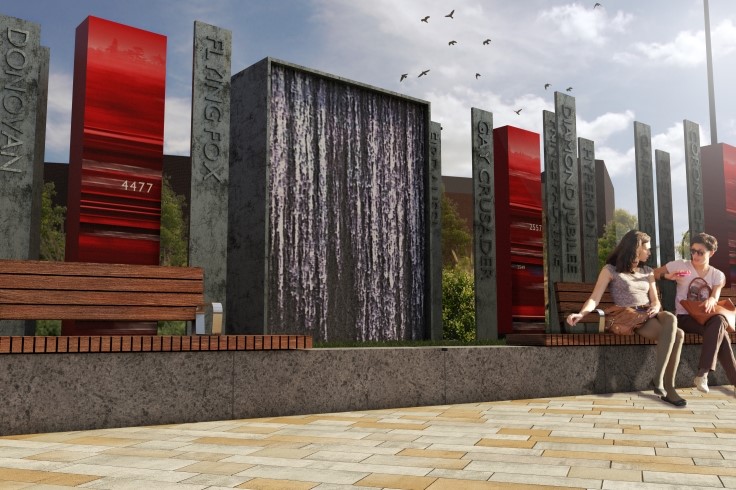Doncaster Train Station Public Art
Public art is central to the transformation of Doncaster's train station forecourt. It is the focal point of the new high quality public space which helps make this an impressive new entrance into the town centre for people arriving by train.
A celebration of engineering, speed and connectivity
It reflects our proud rail and racing heritage
In summary:
- The public art celebrates Doncaster’s rich engineering heritage, speed and connectivity
- It honours locomotives designed by Sir Nigel Gresley
- 47 monoliths in total
- Built in 40mm very heavy steel plate
- 28 detailed with names of St Leger winners
- 12 feature illustrations, notes and scribbles from actual engineering drawings
- 7 striking red monoliths celebrate speed and show images from train journeys around Doncaster
- The colours: Red = the colour of the wheels on the A3 and A4 locomotives, Doncaster green = Flying Scotsman and Garter blue = Mallard
- The full sculptural piece is about 40metres in length
- Each monolith sits up to 3.7metres in height
- 3 impressive water walls and a water fountain add ambience
- It's part of the high quality landscaping throughout the public space
Full explanation of what the art represents
It features 40 monoliths representing Doncaster’s contribution to the age of travel and speed, the quantity of locomotives that The Plant produced and a celebration of the A3 and A4 locomotives designed by Sir Nigel Gresley who became Chief Mechanical Engineer of the Great Northern Railway in 1911. The piece also celebrates the engineering ingenuity and gives a perspective to the volume and scale of locomotives built at Doncaster and the contribution the town made at this important time.
The piece highlights 28 of the locomotives named after St Leger winners as a further celebration of the Doncaster's proud heritage. The names appear in raised 15mm steel plate mounted vertically on the face of the monolith. They are set in the same typeface as they were laid out on the locomotives. They have been designed to have a cast industrial feel to them so they are bold, strong and significant.
12 of the monoliths illustrate details from the original engineering draughtsman’s drawings of the A3 and A4 locomotives. Drawn to scale, they give a clear representation of the size and weight of the locomotives from the inner workings to the wheels. This means when you are stood next to the monolith you feel the size and scale of the locomotives as they were. These illustrated monoliths are laid in order from left to right from the rear of the train to the front. Detailing includes:
- a cross section of boiler tubes;
- innovation of the water collector scoops which enabled the locomotives to go faster and further;
- elevation of the wheels; and
- the distinctive profile of the front of the locomotive.
The detailing includes draughtsman’s scribbles and notes on the dimensions, measurements and references taken from the construction drawings when the locomotives were built in the workshops. This brings a real human element to the design and sculpture.
They are made from very heavy 40mm plate designed as such to demonstrate the quality and weight of the locomotives and represent the overwhelming scale and size. Each monolith stands proud up to 3.7metres in height. The solid, robust, steel celebrates the engineering, craft and workmanship associated with building the locomotives in the Doncaster plant.
In contrast seven striking red monoliths sit in between the steel monoliths. Screen printed in vitreous enamel to give a certain quality finish and very glossy depth to the paint – just like looking into the locomotives paint. These celebrate speed. Each different design is a blurred snippet and flash of the world going by when looking out of the window on a train journey. The images used are taken from the windows of the train around Doncaster on the East Coast Line – creating a true sense of place.
Every detail is carefully considered – each number represents one of the A3 or A4 locomotives built in Doncaster and is blurred into the image to give a sense of speed, a flash of colour in the landscape. Some of the locomotives were also named after birds.
The striking red is a nod to the colour of the wheels often used on the locomotives. To celebrate the pinnacle of speed and ingenuity we have included 4472 the number of the Flying Scotsman in its striking Doncaster green and out in front is the fastest steam locomotive the Mallard in the striking Garter blue . These sit at the front of the full piece – a celebration of the engineering and a pinnacle of development of that type of locomotive.
To complement the piece, there are three big water walls and a water fountain. This adds further interest and create ambience in the newly built public space.
Further information
The council concept was developed and enhanced by Chris Brammall of CB Arts. It was built at his workshop in Cumbria by a team of craftsmen. Further information on CB Arts can be found at CB Arts
More information on the £7.5 million train station forecourt redevelopment and the wider Urban Centre Masterplan which is rejuvenating the town centre is available: Urban Masterplan
Downloads & Resources
Display your introduction over featured image?: No

